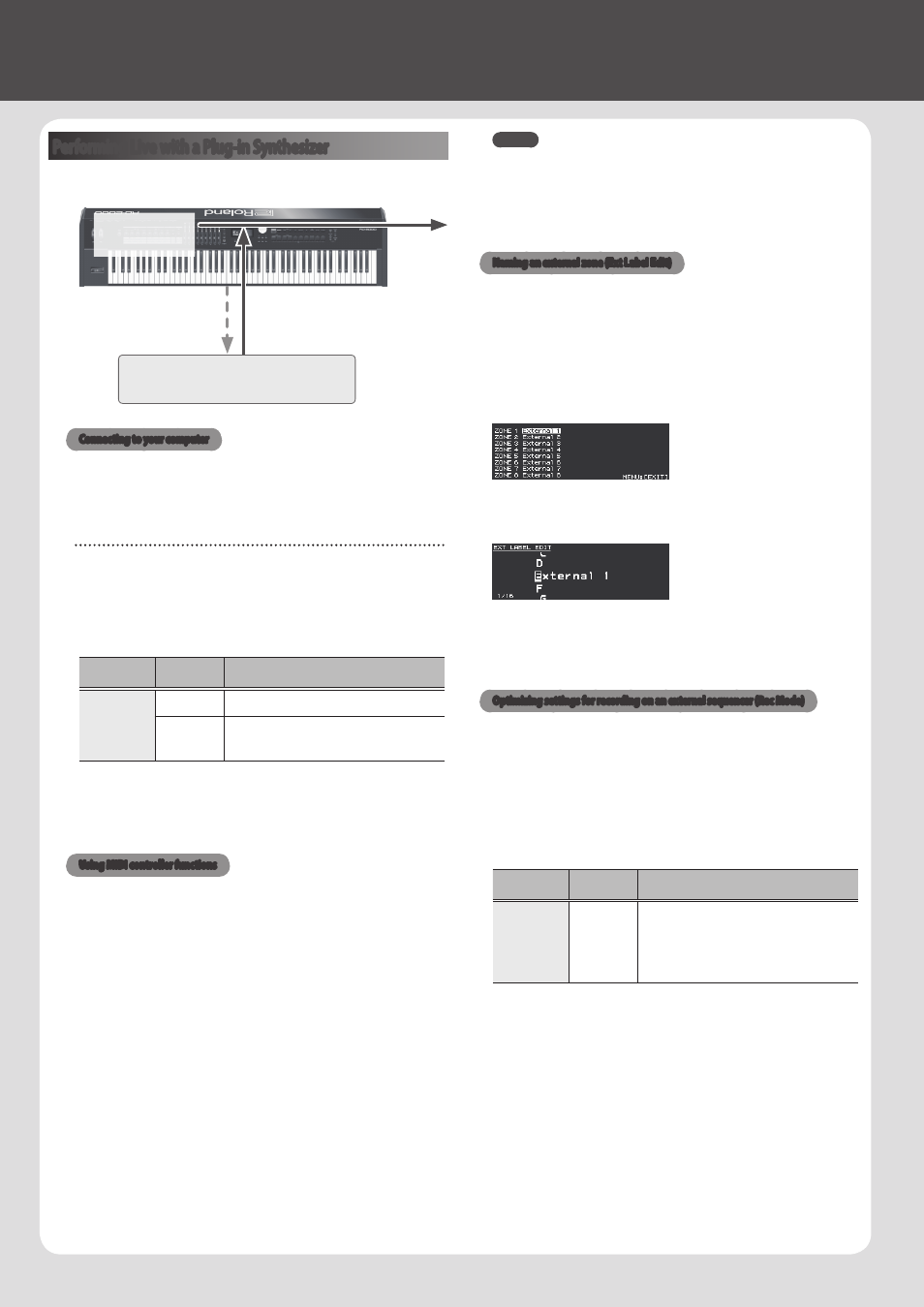Performing live with a plug-in synthesizer, Dit (p. 18, Er (p. 18 – Roland RD-2000 Digital Stage Piano User Manual
Page 18

18
Performing Live with a Plug-in Synthesizer
Here’s how you can use the RD-2000 to play a plug-in synthesizer that’s
installed on your computer.
Performance data
for external zones
(USB MIDI)
Audio from the
computer (USB audio)
Performance using
internal zones
(audio)
Plug-in synthesizer
installed on the computer
Output
Connecting to your computer
In order to use the RD-2000, you need to download the driver from the
following URL and install it on your computer.
For details on installation, refer to the Roland website.
&
http://www.roland.com/support/
USB driver settings
Here’s how to specify the USB driver that’s used when connecting the
RD-2000 to your computer via the USB COMPUTER port.
1.
In the MENU screen, select “SYSTEM” and press the [ENTER]
button.
2.
Set the “USB Driver” parameter to “VENDER.”
Parameter
[
K
] [
J
]
Value
[DEC] [INC]
Explanation
USB Driver
VENDER
Choose this if you want to use a USB driver
downloaded from the Roland website.
GENERIC
Choose this if you want to use the standard USB
driver that was included with your computer.
* Only MIDI is available.
3.
Save the setting.
&
“Saving the system settings” (p. 26)
4.
Turn the power of the RD-2000 off, then on again.
Using MIDI controller functions
Data produced by operating the RD-2000’s knobs and keyboard can be
transmitted as MIDI messages from the RD-2000’s MIDI OUT connector
and from USB MIDI OUT.
1.
Press the SELECT button of the zone that you want to transmit
MIDI.
2.
Hold down the [SHIFT] button, and press the INT/EXT button of
the selected zone several times to make it light green.
MIDI messages are transmitted according to the settings of the zone.
MIDI messages are not transmitted if the button is unlit or lit red.
3.
Press the ZONE EFFECTS [SELECT] button several times to select
“CTRL” or “ASSIGN.”
Knob [1]–[8] information is transmitted if “CTRL” or “ASSIGN” are
selected.
If “EQ” or “REVERB/DELAY” are selected, MIDI messages are not
transmitted.
4.
Make the slider [LEVEL] button or [ASSIGN] button light.
Sliders [S1]–[S8] transmit MIDI messages according to the state of the
[LEVEL] button or [ASSIGN] button.
MEMO
You can make detailed settings in the “EXTERNAL” tab of ZONE EDIT
(p. 21).
5.
Save the specified settings as a scene or program.
&
&
“Saving the Sound Settings in a Program (Program Write)” (p. 23)
Naming an external zone (Ext Label Edit)
You can assign a label to each external zone.
These labels are shown as the external device name in various screens.
1.
Press the [MENU] button.
2.
Use the Cursor buttons to select “Ext Label Edit,” and then press
the [ENTER] button.
3.
Select the zone that you want to name, and press the [ENTER]
button.
If you decide to cancel, press the [EXIT] button.
4.
Assign a name and press the [ENTER] button.
For details on how to enter a name, refer to “Saving the Sound Settings
in a Program (Program Write)” (p. 23).
A confirmation message appears.
If you decide to cancel, press the [EXIT] button.
Optimizing settings for recording on an external sequencer (Rec Mode)
If you’re using an external sequencer to record internal parts, it’s
convenient to use the Rec Mode function.
The Rec Mode function lets you use settings that are optimal for
recording to an external sequencer, without having to edit the zone or
channel settings.
1.
In the MENU screen, select “Local Control” and press the [ENTER]
button.
2.
Set the Rec Mode parameter.
Parameter
[
K
] [
J
]
Value
[DEC] [INC]
Explanation
Rec Mode
OFF, ON
When this is set to ON, settings appropriate for
recording are used with respect to the output
from MIDI OUT, regardless of the INTERNAL
layer settings. Ordinarily, this should be set to
OFF.
(OFF when the system is started up)